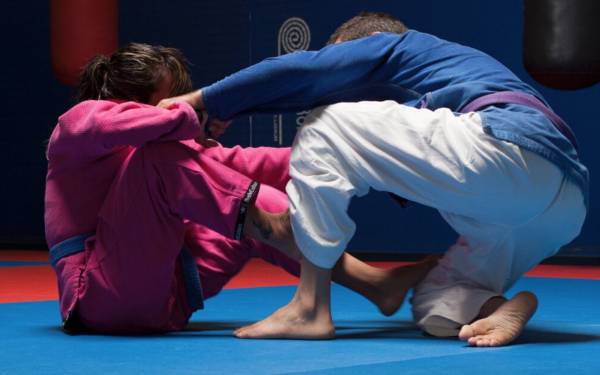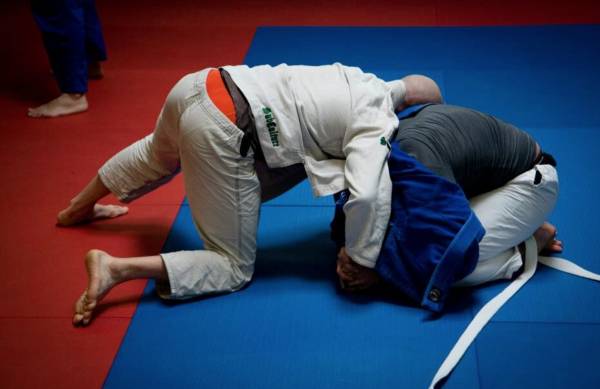It’s almost time. Class is nearing the end, and you cannot wait for your instructor to set the timer for live rolling. Rolling rounds at the end of class is the favorite part for most people who do Brazilian jiu jitsu. It’s the time you can try to tap out another person or you may feel like today is the day you are going to give it to one of the higher belts.
But if you approach rolling with the mindset of, “How many people can I tap out,” then you are going to end up with a short and unsuccessful BJJ career. Rolling is not about how many people you “bat” or the number of points you score. It’s about improving.
Making improvements and leaving the class better then you did when you walked in requires you to have a training goal. For both new and experienced students, goal setting is important. Here are my top suggestions for setting goals for your BJJ training sessions.
Setting the Tone
Before every class, take a few minutes to reflect on what you want to accomplish. Students tend to rush into the academy after a long day at work, change into their gi, and start to socialize or just hang out until class begins. Instead, try this: before you step inside the academy, set your goals for the class (more on the types of goals you can pick below).
After you pick your goals, get an idea in your head of what it would look like to accomplish each one. How do you know when you’ve accomplished your chosen goal? Once you determine that criteria and it is met, then you can move on to another goal. Keep this information written down somewhere in a notebook or electronically, whatever works best for you.
“After you pick your goals, get an idea in your head of what it would look like to accomplish each one.”
It is okay to stick with the same goals for a long period of time. I’m about to share some ideas on potential goals, and you will see there are many types. But most of them are not going to be accomplished in one training session.
The Practice What You Just Learned Goal
This goal works well for all belt levels, including students who are brand new. If you are new, you may feel like you do not know what to do during rolling. Most classes focus on one or two techniques. But despite the fact we spend the first half of class learning the technique, when it comes time to roll we often do not try what we just learned.
Instead, set a goal to attempt the techniques you learned in class during rolling. This helps reinforce what you just learned. If you can pull off the technique in a class full of people who know what you are going for, then your technique and timing is going to improve.

The Positional Improvement Goal
For example, if you have a hard time escaping the mount or passing guard, your goal would be to focus on that particular aspect of your game. When you are rolling, try to put yourself in a position where you have to work on a specific area of your game. If you never get in a bad position or work on positions that are challenging, then you will be without a full arsenal of weapons when someone puts you in that position during a tournament or in rolling. It’s easy to work on your strengths, but the best practitioners work on their weaknesses.
The Physical Improvement Goal
This one is often overlooked and is a great place to start for new students. When you have been training for a while, you often forget how physically challenging BJJ can be. Many new students find it difficult to just complete the warm ups. So, having a goal that focuses on one or two aspects of the physical part of BJJ can be beneficial.
There are many physical goals you can pick from, but here are a few of my favorites:
- Roll every other round during sparring.
- Pick a goal of how many rounds you want to do, in a row or total, and try to get that number.
- Work on your “base” if you find yourself getting swept easily.
- Work on not getting swept from the guard, specifically.
- Pick a physical component of your game that needs improvement and go for it.
Think about your strengths, weaknesses, and techniques, and you can see that the potential goals for physical improvement are endless.

The Technical Improvement Goal
This works best for more experienced students. We all have something to work on. Pick one or two techniques from a few different positions and attempt them during rolling. An example goal list for a training session may look like this:
- Open guard – work knee slide pass
- Closed guard bottom – work triangles
- Side control top – work Kimura attacks
Keep in mind, these are not the only attacks you will be going for during class. They are just the main techniques you are going to work on.
I find this approach works best over the long haul. Some of the best people I have rolled with stick to the same techniques over a long period of time. They practice these techniques until they decide they do not want them as part of their game or they have worked them enough to move on to practicing other techniques.
“It’s easy to work on your strengths, but the best practitioners work on their weaknesses.”
If you look at the top BJJ competitors, they all have a few techniques they are good at and can execute on everyone. One of the surprising benefits of picking a few techniques to work on is that when you stick to the same techniques for a long time, people may start to know what you are going for – then, when you can still pull it off, then you know you have it down.
Bringing it All Together
Brazilian jiu jitsu may appear to be random movements. But the truth is most of those movements are calculated and developed over many years. The best competitors were not born knowing BJJ. They spent years focusing on specific goals to get them to the point where their game looks effortless. No matter where you are in your BJJ journey, you are no different. Set a goal for your training and you will be ahead of those who do not.
More like this:
- 4 Steps to Increasing Strength to Weight Ration for BJJ
- How to Maximize BJJ Training With Minimum Time
- Free Strength and Conditioning Workouts Designed for BJJ
- New On Breaking Muscle Today
Photos courtesy of Ana Nieves.






